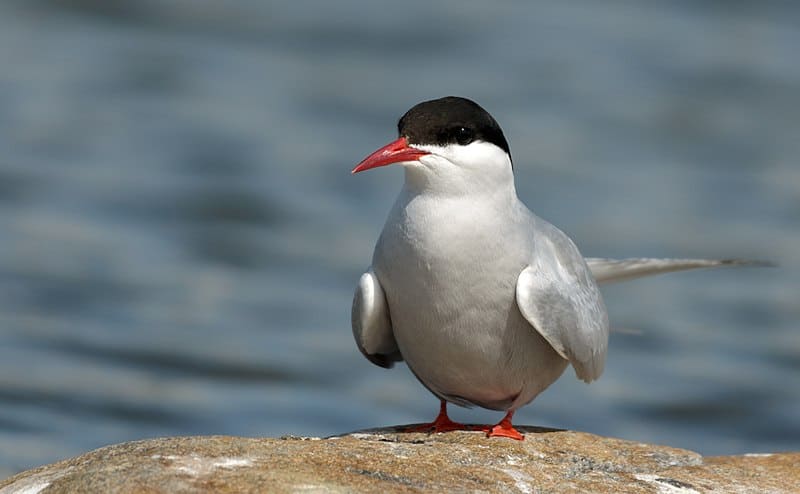Arctic Tern Facts
- The short yet informative title of Arctic Tern serves as the most frequently employed common name for this beautiful winged wonder. The amazing bird does have at least one other general title by which it’s known, though. That’s the occasionally locally used term of sea swallow.
- Within the scientific community, however, it’s possibly significantly better known by its entirely technical designation. Although appealing, that’s slightly more difficult for the layperson to pronounce. That’s because it holds the appellation of Sterna paradisaea.
- The winged wonder received that epithet due to the efforts of Erik Ludvigsen Pontoppidan. Intriguingly, the Danish author and Lutheran bishop recorded the first recognition of it as a separate and distinct species. He achieved that scientifically noteworthy deed in 1763.
- This marvel of the winged world earns high merit for a multitude of reasons, to be certain. Chief among them, though, ranks its extraordinary migratory habits. It undertakes the longest known migrations of any animal on earth. These average 30,300 mi (48,700 km) per year!
- Fortunately, the magnificent Arctic Tern appears to be maintaining both a stable and sufficient population base. That pleasant state also seems to hold true throughout its entire range. The IUCN therefore presently shows it as Least Concern on its Red List of Threatened Species.
- The surprising animal nevertheless still faces several potential threats to its continued existence as a species, at least. Like all forms of life on earth today, most of these many perils stem from the actions of mankind. They include the perils of habitat loss and climate change.
Related Articles
Albatross
Arctic Tern Physical Description
The beautiful Arctic Tern quickly draws the eye of those individuals fortunate enough to encounter the airborne marvel. It does not typically do so, however, due to its sheer size. That’s simply due to the fact that, in that particular regard, it only ranks as a small-to-medium variety of bird.
Yet, Nature cares nothing for such insignificant matters. Regardless of physical dimensions, it puts on a remarkable presence for the observer. The bird also does so without regard to gender, since, unlike many animals, it shows little or no evidence of the characteristic of sexual dimorphism.
Individuals of both sexes thus achieve the same general body measurements. This includes a length averaging approximately 11 – 15 in (28 – 39 cm). It also boasts a modest mean wingspan equaling roughly 26 – 30 in (65 – 75 cm). Exceptional examples occur, though they remain quite rare.
Nature and evolution also provided the smaller bird with a natural feature that many of its larger cousins lack. That’s in the nature of its tail. This appendage develops with a distinctive combination of being strongly forked, relatively long and slender, and possessing elongated outer feathers.
The coloring of the lovely Arctic Tern additionally represents a point of interest among its many observers. That’s due to the fact that this trait is actually quite variable by nature. During breeding season, the animal presents a mostly white body with a light gray shade on the mantle and back.
The amazing winged animal also has a black cap on their head that extends down to their eyes. Its wings show gray with a noticeable black trailing edge. The bill usually displays red with a black tip. Outside of breeding season, however, the plumage becomes significantly duller in coloring.
- Kingdom: Animalia
- Phylum: Chordata
- Class: Aves
- Order: Charadriiformes
- Family: Laridae
- Genus: Sterna
- Species: S. paradisaea
Arctic Tern Distribution, Habitat, and Ecology
The astonishing Arctic Tern, despite its common name, actually inhabits an astounding swathe of the earth’s surface. The full extent of that expansive zone of habitation, in fact, might surprise you. It’s broken up, though, due to the fact that it inhabits different regions in different seasons.
During the southern summer, the Northern Hemisphere’s winter, this winged wonder quickly becomes distributed widely across the Southern Ocean. There, more precisely its range extends, from the Antarctic pack ice to the waters off the coasts of South America, Africa, and Australia.
During the Northern Hemisphere’s winter, however, the creature migrates to the Antarctic region, where it spends the southern summer. This incredibly extensive migration takes the captivating avian from its breeding grounds in the Arctic all the way to the Southern Ocean around Antarctica.
During its breeding season, the intrepid creature displays a moderate degree of flexibility pertaining to its choice of habitat. It’s thus found residing within a reasonably wide range of ecosystems at this time. All of these environments, however, tend to be either in coastal or near-coastal regions.
This frequently includes such settings as coastlines, including various rocky shores, sandy beaches, and even gravelly or grassy areas located near the shore. It also frequently chooses small islands or even islets for nesting. It does so since these provide moderate protection from its predators.
Yet, in some regions, the amazing product of evolution sometimes nests inland on tundra habitats found near freshwater lakes or ponds. In such settings, the selective avian most often prefers open areas with short vegetation where it can easily spot predators and access its nesting sites.
The fabulous Arctic Tern feeds as a pure carnivore, like its many kindred. The vast majority of its diet consists of a variety of smaller fish species. It does, though, augment this with the occasional crustaceans, mollusks, and other small marine organisms. It hunts in a range of several ways.
In turn, it faces its own naturally evolved threats, including avian predators such as skuas, gulls, and jaegers, as well as mammalian predators like foxes and rats. Nest predation can be a significant challenge, leading it to prefer to nest in locations that provide some level of protection.
Species Sharing Its Range
Arctic Fox
Checkout our other articles on 7 Breathtaking Beaches of the World, Indian Giant Squirrel, Komodo Dragon, Pacu, Hibiscus Harlequin Bug, Swell Shark, Common Water Hyacinth

